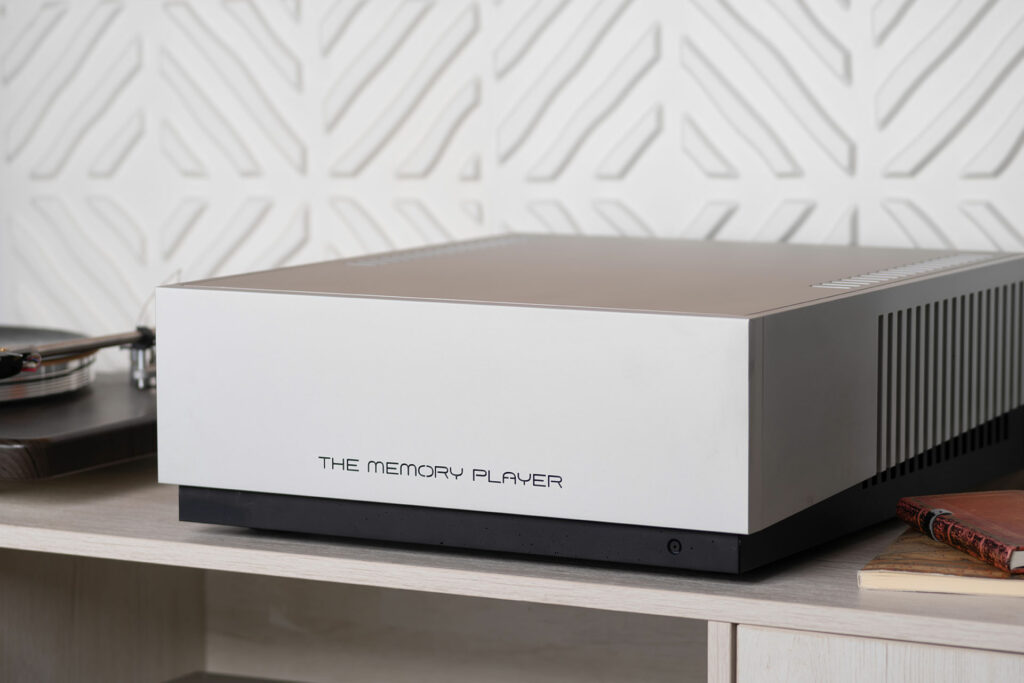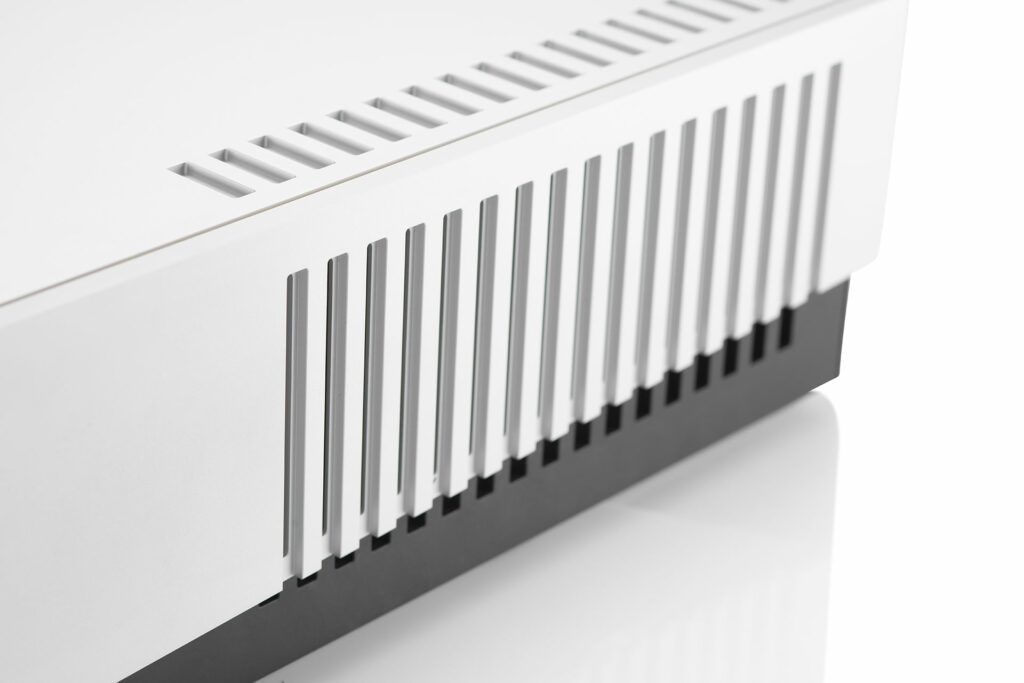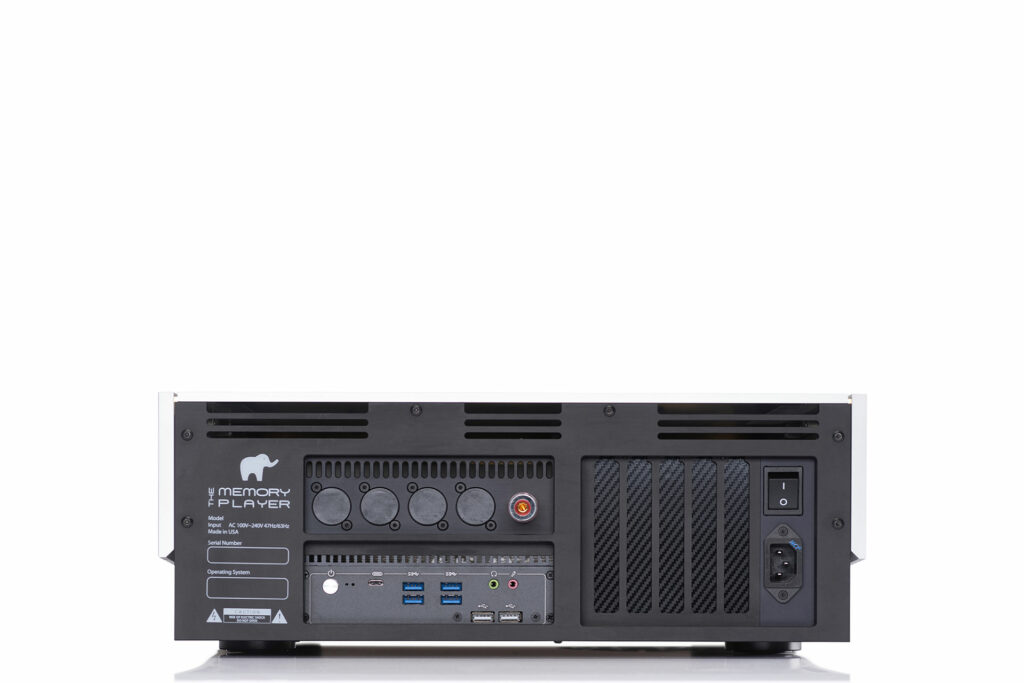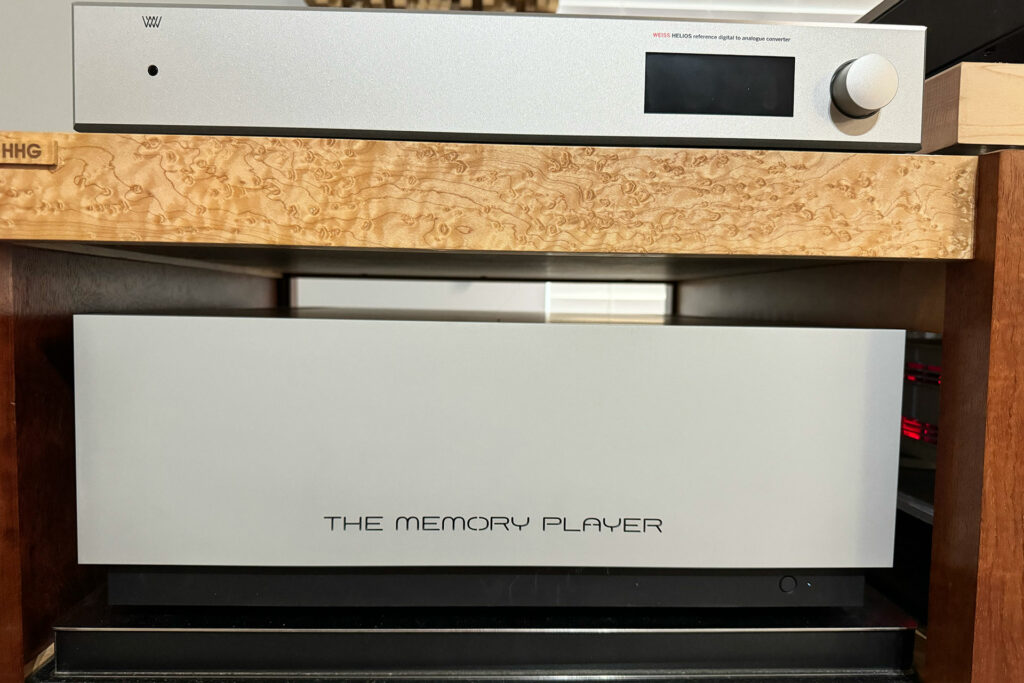Sometime in the late 1990s, audio designer, scientist and quantum physicist Mark Porzilli started thinking about digital music and why he felt it sounded so artificial, with hardly any tangible association to natural-sounding music. In fact, this line of thought occurred about the same time as the rise in popularity of computer-based storage and playback of digital music files. Then as now, we call this technology a music server.
The Laufer Teknik Memory Player 64 is truly unique, in that it is the only music server of which I am aware with the comprehensive capability to reduce packet jitter and even jitter in the byte, sub-byte, RAM memory, hard drives and even the computer operating system. It is also the only music server of which I am aware that effectively bypasses the presumably outdated Rubidium Atomic Master Clock. The Laufer Teknik Memory Player 64’s solutions are software-based reportedly capable of increased improvements of up to 500 times greater in global jitter reduction. This capability is claimed to far surpass any of the legacy or current music servers or streaming devices in today’s marketplace.

Having an understanding of computer code and physics, Porzilli very early reasoned that the principal enemy of high-quality digital playback was jitter. Because of the underlying inefficiencies in digital code as it relates to superior audio playback, copying a CD, downloading a music file, or streaming any song from audiophile music sites creates the certainty of high levels of jitter and the inevitability of reduced sonic quality. Worse still, much of this jitter occurs before the music signal ever reaches the DAC, or is converted to a familiar digital file (like 44.1/16). This means the corrupted signal is effectively blind to the DAC. Equally undesirable, all of the normal functions of a computer may serve to increase jitter to appalling levels. All of these conditions allow for the often harsh “digital” sound so many analog proponents abhor.
Porzilli was once quoted as saying, “Without getting too encumbered by the verbiage itself, digital audio code theory is about determining the location of a bit in a given time frame. In code, it’s known as the Probability of Vicinity. Being knowledgeable of computers offers literally little advantage here. It’s the shell of the egg. It’s physics time.”
The entire essence of the Laufer Teknik Memory Player 64 is having sufficient time to employ multiple jitter reduction technologies with no loss of performance or time lag in playback.Towards that end, the Memory Player uses various jitter reduction processes, two of them awarded a U.S. patent and one with patent pending, which enable the reproduction of digital music with a sonic presentation sounding more like music and less like a digital file. Let’s look into some of those processes.

What Makes the Laufer Teknik Memory Player 64 So Special?
- The core of the Laufer Teknik Memory Player 64 jitter reduction is a program called I.D.E.A.S. This acronym stands for “Impulse Discharge of Events In Atemporal Space.” This patented program (US Patent 8995243) runs in real time, reads and re-reads the digital signal to remove vacancies, and zeros in the audio code, which cause significant levels of jitter. These vacancies and other associated code errors always occur when a music file is copied, downloaded or streamed. It then rearranges the data back to its original sequential order which, if not implemented, compromises the file and is a source of increased jitter. This jitter occurs even before the file has been converted to 44.1/16 (or high-res) or even sees the DAC. At that point, it cannot be corrected by conventional means.
- I.D.E.A.S.2 is similar in its ability to reduce jitter, but whereas IDEAS focuses on the digital file itself, IDEAS2 applies jitter reduction technologies to the computer operating system – also a source of increased jitter.
- DeFractionalized Memory (U.S. Patent 8451701) is a slot memory which reduces jitter on all files placed in its structure. It creates a “virtual clock,” utilizing only one clock tick out of 16, which vastly improves the accuracy of the clock, thereby reducing jitter and improving sonics. Porzilli states this process can improve clocking accuracy by as much as 94 percent. This patented memory structure has no known equal in high-performance audio and provides sonics with a more natural sound and, happily, far less digital-sounding music playback.
- Because streaming has reached such a high level of popularity with audiophiles, Porzilli recently released a program to reduce jitter on a music file streamed in real time from the Internet. Over two years in development, this patent pending software program captures the streamed file in a FIFO arrangement, decompresses it as a DSD file, places it in a DeFractionalized Memory slot, applies the IDEAS technology for reduced jitter, and then plays the music file. All of this happens instantaneously and occurs completely seamlessly. Streaming music has come a long way, but is still subject to time-based distortions when the file is downloaded, reconstituted as music, and played back through a computer or similar device. This technology works with almost any current streaming and playback system, including Roon, JRiver, Tidal and Qobuz.
- Because of the outdated nature of atomic clocks used in music playback, the Laufer Teknik Memory Player 64 uses a custom-designed program that Porzilli created, called the “Clock Mapper.” This technology takes all audio processes into consideration, even changes in the state of computer chips, and isolates all processes into one clock, thereby removing almost all associated jitter. This program is a replacement for the 1980s-era rubidium atomic master clock, which has changed very little, if at all, since its birth when digital music was first introduced.
- There is a program to convert and store physical CDs and downloads to a 64-bit file and play back as a 32-bit file. Converting music files to 64-bit and playback at 32-bit allows for more information to be captured and renders increased dynamics, improved bass response, greater soundstaging and imaging, increased clarity and, overall, vastly improved sonics.
- An internal 4TB SSD hard drive can store copied music converted to a “Wave 64” file structure. USB slots allow for limitless storage.
- All of the conventional inputs are available, including USB, AES/EBU, RCA, XLR, TosLink and Ethernet. Custom connections are also available.
Why Should You Care About the Laufer Teknik Memory Player 64?
It goes without saying that, in today’s modern era, digital music is the preferred playback method. While streaming pretty much rules supreme, there are still vast libraries of physical CDs. How then do we make these two mediums, arguably the cornerstone of our primary listening methodologies, sound less like a harsh, bright, digital file and more like natural music? How do we achieve basic sonic improvements in a digital signal? There are many ways in which digital music may be recreated. Some are better than others. I’m not aware, nor have I heard thus far, any digital system whose sonic presentation is less digital-sounding than the Memory Player. Anyone in search of a playback system with a uniquely natural, some might even say analog, sound should care about this device.

Some Things You Might Not Like About the Laufer Teknik Memory Player 64
- There are audiophiles who have limited space and prefer a streaming device built into an existing component – integrated amp, DAC or something similar.
- Some may be leery of the advanced technology and what happens if something goes wrong. Not to worry, Laufer Teknik has the ability to remotely access all Memory Players and make repairs, offer “tune-ups” and even install new software. In fact, the unit may be returned and have new hardware installed or even completely rebuilt – making it very much future-proof.
- Some may really prefer a simpler, lower-cost device. Laufer Teknik offers the Memory Player Mini ($7,500), which has the essential, albeit scaled- down, programs as the full-sized unit, only at a much lower though still significant cost.
Listening With the Laufer Teknik Memory Player 64
Almost any audiophile knows what digital harshness sounds like: that grating, almost screeching sound analog proponents cannot abide. What the Laufer Teknik Memory Player 64 provides is all the things we love about digital – concussive dynamics, dynamic range, clarity and a low noise floor. It goes beyond those attributes, however. The Laufer Teknik Memory Player 64 provides a unique listening experience separate and apart from almost any competing digital playback system. Combining visceral dynamics, pinpoint imaging, incredible retrieval of detail (especially transients), accuracy and a natural sense of music effortlessly flowing along, I find the Memory Player to be a completely immersive listening experience.
Take three Michigan brothers, add a drummer, let the guy who sounds eerily like Robert Plant handle vocals, and the amalgam is a band sounding a lot like Led Zeppelin. In their seminal release, From the Fires, Greta Van Fleet does all of these things on their track “Flower Power.” What starts as an almost folk intro quickly diverges into a fantastic 1970s-era rock and roll song. At about the 2:40 mark, lead singer Joshua Kiszka launches into a scream certain to please any Zeppelin fan. This is followed by a really superb guitar riff that, through the Laufer Teknik Memory Player 64, was portrayed cleanly, clearly and precisely. This track has moving parts, as evidenced at the 3:40 time mark, when things slow down to a simple organ, which on my system sounded like the keyboardist was in the room with me. Led Zeppelin wannabees? Who can say? I only know I like their vibe.
I always enjoy a song that tells a story. On the 2017 Mary Chapin Carpenter release titled Party Doll, the track “This Shirt” tells the story of a shirt and its impact on a life. Normally, I tend to lean towards big, magnanimous works with a huge soundstage and massive dynamics. Quite the opposite, “This Shirt” is soft, simple, and the imaging is barely wider than my audio rack. I was impressed at how the Laufer Teknik Memory Player 64 was able to capture the narrow, almost confined image presentation of what I presume the recording intended to portray. It is a slow-paced folk song, and I heard it exactly as such. The acoustic guitar sounded very realistic and lifelike. Accurate is also a term I would apply to this recording. The simplicity of this song belies the simple pleasure of listening to a song on a quality audio system, as opposed to hearing a recording.
Will the Laufer Teknik Memory Player 64 Hold Its Value?
Over the years, there have been Memory Players sold on the used market, but it is a pretty rare occurrence. It is a device that has been around for almost two decades, so it is a known factor. although not as well-known as some other brands. Admittedly, it is not a component sold used with great frequency. Why? I suspect many owners simply like them too much to part with them. Or, equally, because of Laufer Teknik’s remote services and the ability to return the unit for hardware upgrades, many owners really keep using them. For these reasons, the Laufer Teknik Memory Player 64 should hold its value quite well – when one actually appears for sale used.

What Is the Competition for the Laufer Teknik Memory Player 64?
Given all the custom and patented software, there are no real direct competitors. However, music servers, and streaming devices in general, are in a very crowded field, with more available products at all price levels than one can imagine. There are, however, some very popular devices that, while not as advanced as the Memory Player, offer superior digital playback.
At $20,100 ($26,200 for upgraded power supply version) the Innuos Statement is a very highly-regarded and awarded music server. It can rip (copy) a physical CD, store it on a self-contained 4TB hard drive, and play music files with a custom Innuos app for a handheld device. It is a two-box unit, meaning the power supply is in a separate enclosure. A primary feature is noise reduction.
Enjoying more than a decade of popularity is Aurender and, in this case, their flagship N30SA retailing for $25,000. Like the Innuos, the N30SA is a two-box solution, with separate enclosures for the power supply and the rest of the electronics. Also like Innuos, considerable attention is dedicated to noise reduction. The N30SA has up to 8TB of SSD storage, and Aurender’s Conductor app for managing playback is one of the best in the business. I did find it interesting that Aurender dedicates considerable resources to atomic clock accuracy. Conversely, Laufer Teknik’s position is that the multi-decades old rubidium atomic master clock is outdated, and the clocking solutions in the Memory Player far exceed anything existing clocking technologies can provide. In any event, Aurender has cemented itself as an industry leader and offers a wide range of products at multiple price levels and features.
Lastly is the Wadax Server. This over-the-top server sells for, depending on the configuration, somewhere in the $80,000 to $100,000 range. Pair it with the Wadax DAC and be prepared – this duo, fully loaded, will set you back about $250,000. So, why mention it at all? Good question. Actually, I wanted to point out how much excessive spending can occur in this hobby. I’ve heard the full Wadax duo in two different systems, each with retail cost of over $1,000,000. Both systems sounded spectacular, but not nearly at a level I would expect from a seven-figures-plus audio system. Others may disagree.

Final Thoughts on the Laufer Teknik Memory Player 64…
I have been using a Memory Player for more than 10 years, and each new iteration is better than the one before. My current and most recent version incorporates a complete rethinking on Porzilli’s part of how digital recordings may be recreated and improved. Most of the technology is proprietary for obvious reasons, but what I can say is how breathlessly magnificent this new device sounds. Music sounds like music. I hear far greater detail in tracks I have heard countless times, and with excellent bass definition, great clarity and unquestionably the best imaging I have ever heard on my system. I qualify this based on when I traded in my old Memory Player for the new version and my jaw immediately dropped at the improved sonics.
Porzilli offers this statement: “I have gone into this problem of timing in digital audio at a depth that has never been attempted, creating proprietary technologies like The Clock Mapper, De-Fractionalized Memory, IDEAS/IDEAS2 to optimize the audio source material before we even think about heading to the output.”
Porzilli’s statement sums up my final thoughts on the Laufer Teknik Memory Player 64. I feel this device stands alone in regard to jitter reduction, and proffers a musical experience encapsulating all we like about digital, while eliminating what we do not like. Very simply, it makes music sound like music, not a harsh, discordant digital file being played by a computer. It is and will remain my reference for digital audio playback.




This sounds like a fascinating unit. I wish you would have provided more of how you used the unit, it’s still not clear whether this is a DAC inside or I would need one, how would I get music onto the internal drive, drag and drop, can I rip with the unit? Do they have an app, is there a remote? No mention of outputs. You did provide a picture of the back but you have to be able to see in order for that to be of any help.
Good choice for a review, maybe I can find more info online. I’d love to hear one maybe a room at AXPONA is in order.
Bryan, Thanks for your response and for reading the review! The Memory Player (MP) typically comes with a DAC inside but because I have my own DAC, I always opt for not having one built in. If you have your own standalone DAC you don’t need the internal version. Or, specify the internal DAC. Like in all digital audio, however, a DAC of some sort is required. To load music simply connect a CD drive to a USB on the back of the MP. There is a special program included to rip the CD, run the IDEAS program, convert the file to what is called a WAVE 64 file, and then stores the file on an internal hard drive as a 32 bit file for playback. Additional storage is easy with an external SS hard drive. For music that is downloaded from the Internet, a separate program also converts the downloaded file to a WAVE 64 file (64 bit) and also stores it as a 32 bit file for playback. While there is no app, for instance, like the Conductor app on all Aurender servers, there are plenty of remote apps which may be used on a handheld device. I use Splashtop for controlling the Windows computer part of the MP but there are many others as well. Laufer Teknik facilitates remote services with LogMeIn. I use the Roon remote for my iPad to control Roon on the MP. Roon and JRiver, by the way, are fully approved and supported for use on the MP. Either one or both can be preinstalled before the unit is shipped to you. If you use something different, it can be accommodated as well. As to outputs, every type of connection used in audio today is included on the back. In fact, the unit can be custom designed to include specific inputs and outputs. This is a very customizable device which is one reason I like it so much. More than that, however, I find the sonics to be outstanding. That’s the real star of the show. Hope this answers your questions.
Thanks,
Paul
While I’m sure this is a very good player much of the technologies employed are goobledygook. There are only two factors in streaming: (1) the bit-error-rate (BER) of the link & standard technologies used at the receiver to detect & correct data errors (2) the phase noise (jitter) of the DAC clock. (1) has been solved by electrical & computer engineering decades ago. (2) the use of first-in-first-out data memory (FIFO) & clock phased-locked-loop (PLL) phase noise reduction circuits, both available for decades.
Ask yourself this, when was the last time you downloaded known good software & on running found your computer crashed due to a transmission error? I hope your answer is, not in living memory.
As a side note, I’ve always wondered why CD players never featured data error detection rate & corrected error rates displays? Perhaps too scary to let users know how bad their discs were (pinholes, blemishes etc)?
I have used the Memory Player with a small screen almost 20 years ago, then upgraded to a 64 and looking to upgrade again in the near future. I will never consider another streamer because I have never heard digital music sounding so analogue. I wonder at the critics of Mark Porzilli products that, without ever listening to his devices, find issues with his solutions; I invited to listen the MP64 an acquaintance that works in IT and uses a MAC for streaming and decoding. It was hard for him to accept that there is software that can be so absolutely brilliant processing audio files. Indeed, everything else out there is doing a poor job of it.
I will like to ask if the digital output on the latest Memory Players support I2S format.
Thank you for a great description of the Memory Player historical achievements and of the new devices.